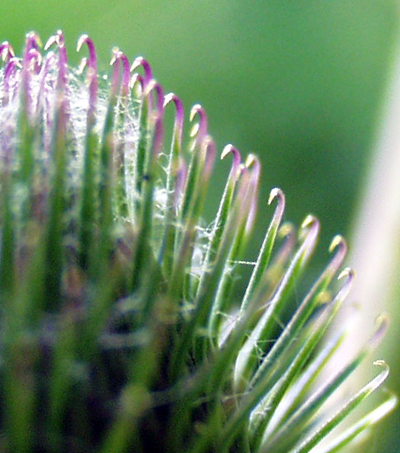Arctium, burdock |

Burdocks are large, shrubby growing herbs

The phyllaries of the burdock have small hooks
The scientific name Arctium probably comes from gr. Arctos (Bear). If really the burdock was meant, it could refer to the occurring of woolly hairs on the involucre of A. tomentosum or on the phyllaries itself, which reminded the authors of a rough bearskin. The English term is made up of "bur" (infructescence with barbs) and refers to the similarity of the leaves with the dock (Rumex).
Comprising of 10 species the genus is native to Eurasia and North Africa, but now spread over all continents. The biennial to perennial, often wide-spreading branched herbs have an erect, grooved or angular, strong, sometimes arachnoid-hairy stems and a thick, fleshy taproot. The often large, entire or toothed, often wavy, long-stalked leaves are arranged basal and cauline, on their underside they are often tomentose. The petioles are furrowed above. The alternate stem leaves decrease upwards in size.
The flower heads, which exclusively consisting of 5 to about 40 violet, pink or white, hermaphrodite, deeply 5-dentate disc florets, are stalked or sessile and arranged in racemose, paniculate or corymbiform inflorescences. The receptacle is flat and bristly. The spherical or egg-shaped involucre is made up of numerous phyllaries, arranged in 9–17 rows. They lie on one another like roof tiles. The outer and middle phyllaries are narrowly linear with protruding spikes, the internal ones are linear and appressed. The tips are bent inwardly hook-shaped.
After self or insect pollination are formed elongated, flattened, rough or ribbed, black-grey spotted, glabrous nut fruits (achenes), at the apex with 1–3 mm long, yellowish, rough pappus hairs which are arranged in 2–4 irregular rows. The achenes are spread when a person or an animal stuck on with the involucre, whereby the infructescence sometimes breaks off. Often, however, especially on younger plants, the infructescence remains on the plant. The branch then will spring back after detachment and flings the fruits out of the infructescence.
| Floral formula: |
| * K=pappus [C(5) A5(connate)] G(2) inferior |
Meaning of the species names
- minus: lat. minor = smaller
- lappa: Pliny's name for the burdock
Interesting notes
- The genera Arctium, Cousinia, Hypacanthium and Schmalhausenia form a group of uniform parentage. Within this group, the relationships are not as clear. Some Cousinia species are so closely related to Arctium that they could be attributed to the latter genus.